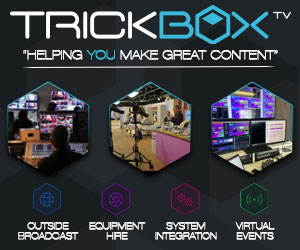Broadcast News
24/10/2017
IBC 2017 Viewpoint

The first North Atlantic autumn storm Aileen blew the broadcast industry into Amsterdam for the annual technology festival that is IBC. Some exhibitors and visitors arrived earlier than others!
Every year, manufacturers tell broadcasters that they are facing the most challenging set of conditions of a generation to do business in. This IBC certainly felt challenging. Was storm Aileen the pre-cursor to a stormy show?
For the last couple of years, IP has been touted as the heir apparent to serial digital video. COTS (Commercial Off-The-Shelf) is an acronym everybody in the broadcast business is now familiar with. If you have investigated the COTS offering, it is not your Fry's or Currys PC World shelf that these products reside on.
Broadcasters headed to NAB Las Vegas in April in the hope that SMPTE had managed to find agreement between the manufacturers. No agreement was forthcoming at NAB and the lead up to IBC had seen a repeat of the question: Will they or won't they publish SMPTE-2110?
The conference started; no announcement. The exhibition started; no announcement. Then, on the Sunday, SMPTE announced that SMPTE-2110 had been ratified, with some minor exceptions. The last major obstacle to mass adoption of Video-over-IP in broadcasting had been removed. The multi-vendor interoperable world that they had enjoyed with SDI was now available in IP.
Or is it? As with any standard, it is worth reading the small print, even if it is extremely technical.
The SMPTE ST 2110 standards suite is multipart, with the essential parts now technically stable. The following is the current status of documents included in the suite, as of September 2017:
SMPTE ST 2110-10/-20/-30 (addressing system concerns and uncompressed video and audio streams) are now approved standards.
SMPTE ST 2110-40 (concerning metadata such as captions, subtitles, active format description, time codes, dynamic range, and more) is presently undergoing final committee draft ballot and is expected to be published before the end of 2017 or in early 2018
SMPTE ST 2110-21 (specifying traffic shaping and delivery timing of uncompressed video) is presently in the comment resolution phase of the final committee draft text. The SMPTE standards committee is now resolving final comments before conducting the final ballot (draft publication) to bring ST 2110-21 to standard status. This document is expected to be published before the end of 2017 or early in 2018
Additional portions of the standards suite, such as support for compressed audio and video, will follow a similar process and will likely be published in time for 2018 NAB Las Vegas.
SMPTE ST 2110-21 (specifying traffic shaping and delivery timing of uncompressed video) is not included in the now approved standard. One of the major benefits of IP is that audio, video and metadata can go their different ways and then be reunited ahead of delivery to their final destination. If we don't have a standard for timing, how will they all join up together and be synchronised?
Then there is SMPTE ST2110-40, concerning metadata such as captions, subtitles, active format description, time codes, dynamic range and more, in fact all the things we take for granted in an SDI world.
So we have a standard that allows us to use uncompressed video and audio streams, but all of the important information we take for granted with SDI has yet to be addressed.
SMPTE-2110 is an interesting standard as it appears to have been widely adopted and deployed before its actual ratification. Heading into the show were a plethora of manufacturers promoting their products. It will be interesting to see if they have managed to steal a march on their competitors or will have to address the ratified revisions of these standards retrospectively.
Customers too seem keen to embrace the new standard, with a number of tenders making reference to SMPTE-2110. A number of those tenders have challenging budgets for a traditional SDI infrastructure so it will be interesting to see if they can achieve the same level of functionality they are accustomed to.
On the upside, we now have agreement on the fundamentals to start working with. Or do we? Discussions were ongoing at IBC that there may be issues between software implementations of SMPTE-2110 and hardware implementations. In an IP world, data has a habit of being sent in bursts, which the software implementations are designed to handle. Hardware implementations on the other hand appreciate constant data streams because bursts tend to fill data buffers. In a non-broadcast IP world that is okay because the transmission protocols simply resend the data that the buffer ignored when it was full. In a broadcast world that is unacceptable as it will result in interruptions to the video stream. This appears to be a watch-this-space discussion.
There also now appears to be a multitude of original equipment manufacturers (OEMs) offering their SMPTE-2110 products to other manufacturers to implement in their technology. Surprise surprise, the manufacturers who have developed their own SMPTE-2110 products are questioning the reliability and future upgradability of these OEM offerings.
Interoperability is vital for broadcasters and this is where the Alliance for IP Media Solutions (AIMS) needs to move to the next stage. Having helped defined SMPTE-2110, AIMS now needs to implement a certification programme. Self-certification is the simplest option with manufacturers measuring their products' performance against an agreed published certification standard from AIMS. The more popular method among broadcasters is independent certification, where a third party independently evaluates manufacturers' products. This way a 'SMPTE-2110 – AIMS approved' reference will give broadcasters the confidence that interoperability has been tested and they can deploy a multi-vendor system with confidence.
The second great technology challenge of high dynamic range (HDR) is becoming a lot clearer but what the broadcast industry has yet to decide is whether to focus on UHD or HD. A number of broadcasters have only recently completed their migration from SD to HD and have not yet even started planning for UHD. HDR is on their radar and everybody agrees that there is a ‘wow’ factor to HDR images, even in HD. Some camera manufacturers at this show have made the bold move of launching HD-only HDR cameras, as they feel there is a huge potential marketplace for HD HDR.
The debate continues as to whether Slog-3, HLG or PQ is used in acquisition. Sony continues to position Slog-3 as a mastering HDR format that will allow broadcasters to down-convert to HLG or PQ. HLG continues to be favoured by broadcasters as it requires only a single production workflow and no metadata, unlike PQ.
Now venturing into the fray is ARRI which has a long and successful history in the film and high end feature television production. ARRI is now positioning its products to work in a live production environment. This will bring Log-C into the mix so having production tools that are capable of working in all flavours of HDR that might be used during acquisition is key.
Finally, resolution. UHD was everywhere this year at IBC: cameras, displays and test and measurement devices. Now with the 2020 Summer Olympics starting to focus broadcasters' minds, Sony has joined the 8K camera race, featuring a newly developed 1.25-inch 8K 3CMOS sensor with 7680 x 4320 resolution and standard 2/3 inch 4K lens with lens adaptor. With UHD being challenged by HD HDR in Europe and America, 8K could prove to be a very niche market.
What we learnt from IBC 2017 is that the industry will continue to develop and evolve. I haven't even discussed virtual reality, artificial intelligence or cloud-based production in this review. Each is undergoing similar monumental upheaval.
Let us hope that the missing SMPTE-2110 standards will have been ratified by, or before, NAB Las Vegas in April 2018 so the next stage of the broadcast adventure can progress.
This article is also available to read in the October edition of Broadcast Film & Video here, page 28.
(JP/LM)
Every year, manufacturers tell broadcasters that they are facing the most challenging set of conditions of a generation to do business in. This IBC certainly felt challenging. Was storm Aileen the pre-cursor to a stormy show?
For the last couple of years, IP has been touted as the heir apparent to serial digital video. COTS (Commercial Off-The-Shelf) is an acronym everybody in the broadcast business is now familiar with. If you have investigated the COTS offering, it is not your Fry's or Currys PC World shelf that these products reside on.
Broadcasters headed to NAB Las Vegas in April in the hope that SMPTE had managed to find agreement between the manufacturers. No agreement was forthcoming at NAB and the lead up to IBC had seen a repeat of the question: Will they or won't they publish SMPTE-2110?
The conference started; no announcement. The exhibition started; no announcement. Then, on the Sunday, SMPTE announced that SMPTE-2110 had been ratified, with some minor exceptions. The last major obstacle to mass adoption of Video-over-IP in broadcasting had been removed. The multi-vendor interoperable world that they had enjoyed with SDI was now available in IP.
Or is it? As with any standard, it is worth reading the small print, even if it is extremely technical.
The SMPTE ST 2110 standards suite is multipart, with the essential parts now technically stable. The following is the current status of documents included in the suite, as of September 2017:
SMPTE ST 2110-10/-20/-30 (addressing system concerns and uncompressed video and audio streams) are now approved standards.
SMPTE ST 2110-40 (concerning metadata such as captions, subtitles, active format description, time codes, dynamic range, and more) is presently undergoing final committee draft ballot and is expected to be published before the end of 2017 or in early 2018
SMPTE ST 2110-21 (specifying traffic shaping and delivery timing of uncompressed video) is presently in the comment resolution phase of the final committee draft text. The SMPTE standards committee is now resolving final comments before conducting the final ballot (draft publication) to bring ST 2110-21 to standard status. This document is expected to be published before the end of 2017 or early in 2018
Additional portions of the standards suite, such as support for compressed audio and video, will follow a similar process and will likely be published in time for 2018 NAB Las Vegas.
SMPTE ST 2110-21 (specifying traffic shaping and delivery timing of uncompressed video) is not included in the now approved standard. One of the major benefits of IP is that audio, video and metadata can go their different ways and then be reunited ahead of delivery to their final destination. If we don't have a standard for timing, how will they all join up together and be synchronised?
Then there is SMPTE ST2110-40, concerning metadata such as captions, subtitles, active format description, time codes, dynamic range and more, in fact all the things we take for granted in an SDI world.
So we have a standard that allows us to use uncompressed video and audio streams, but all of the important information we take for granted with SDI has yet to be addressed.
SMPTE-2110 is an interesting standard as it appears to have been widely adopted and deployed before its actual ratification. Heading into the show were a plethora of manufacturers promoting their products. It will be interesting to see if they have managed to steal a march on their competitors or will have to address the ratified revisions of these standards retrospectively.
Customers too seem keen to embrace the new standard, with a number of tenders making reference to SMPTE-2110. A number of those tenders have challenging budgets for a traditional SDI infrastructure so it will be interesting to see if they can achieve the same level of functionality they are accustomed to.
On the upside, we now have agreement on the fundamentals to start working with. Or do we? Discussions were ongoing at IBC that there may be issues between software implementations of SMPTE-2110 and hardware implementations. In an IP world, data has a habit of being sent in bursts, which the software implementations are designed to handle. Hardware implementations on the other hand appreciate constant data streams because bursts tend to fill data buffers. In a non-broadcast IP world that is okay because the transmission protocols simply resend the data that the buffer ignored when it was full. In a broadcast world that is unacceptable as it will result in interruptions to the video stream. This appears to be a watch-this-space discussion.
There also now appears to be a multitude of original equipment manufacturers (OEMs) offering their SMPTE-2110 products to other manufacturers to implement in their technology. Surprise surprise, the manufacturers who have developed their own SMPTE-2110 products are questioning the reliability and future upgradability of these OEM offerings.
Interoperability is vital for broadcasters and this is where the Alliance for IP Media Solutions (AIMS) needs to move to the next stage. Having helped defined SMPTE-2110, AIMS now needs to implement a certification programme. Self-certification is the simplest option with manufacturers measuring their products' performance against an agreed published certification standard from AIMS. The more popular method among broadcasters is independent certification, where a third party independently evaluates manufacturers' products. This way a 'SMPTE-2110 – AIMS approved' reference will give broadcasters the confidence that interoperability has been tested and they can deploy a multi-vendor system with confidence.
The second great technology challenge of high dynamic range (HDR) is becoming a lot clearer but what the broadcast industry has yet to decide is whether to focus on UHD or HD. A number of broadcasters have only recently completed their migration from SD to HD and have not yet even started planning for UHD. HDR is on their radar and everybody agrees that there is a ‘wow’ factor to HDR images, even in HD. Some camera manufacturers at this show have made the bold move of launching HD-only HDR cameras, as they feel there is a huge potential marketplace for HD HDR.
The debate continues as to whether Slog-3, HLG or PQ is used in acquisition. Sony continues to position Slog-3 as a mastering HDR format that will allow broadcasters to down-convert to HLG or PQ. HLG continues to be favoured by broadcasters as it requires only a single production workflow and no metadata, unlike PQ.
Now venturing into the fray is ARRI which has a long and successful history in the film and high end feature television production. ARRI is now positioning its products to work in a live production environment. This will bring Log-C into the mix so having production tools that are capable of working in all flavours of HDR that might be used during acquisition is key.
Finally, resolution. UHD was everywhere this year at IBC: cameras, displays and test and measurement devices. Now with the 2020 Summer Olympics starting to focus broadcasters' minds, Sony has joined the 8K camera race, featuring a newly developed 1.25-inch 8K 3CMOS sensor with 7680 x 4320 resolution and standard 2/3 inch 4K lens with lens adaptor. With UHD being challenged by HD HDR in Europe and America, 8K could prove to be a very niche market.
What we learnt from IBC 2017 is that the industry will continue to develop and evolve. I haven't even discussed virtual reality, artificial intelligence or cloud-based production in this review. Each is undergoing similar monumental upheaval.
Let us hope that the missing SMPTE-2110 standards will have been ratified by, or before, NAB Las Vegas in April 2018 so the next stage of the broadcast adventure can progress.
This article is also available to read in the October edition of Broadcast Film & Video here, page 28.
(JP/LM)
Top Related Stories
Click here for the latest broadcast news stories.
13/03/2017
PROVYS: Always The Gold Standard In Broadcast Management
It goes without saying that every broadcaster in the world has to ensure the smooth and efficient control of complex workflows, this being a non-negot
PROVYS: Always The Gold Standard In Broadcast Management
It goes without saying that every broadcaster in the world has to ensure the smooth and efficient control of complex workflows, this being a non-negot
06/08/2008
dB Broadcast Announces Showman 1000 Multi-Standard TV Receiver/Demodulator
dB Broadcast, the Cambridge-based leading UK independent system integrator, has announced the release of the Showman 1000 series of multi-standard ana
dB Broadcast Announces Showman 1000 Multi-Standard TV Receiver/Demodulator
dB Broadcast, the Cambridge-based leading UK independent system integrator, has announced the release of the Showman 1000 series of multi-standard ana
13/11/2024
SMPTE And Avid Publish New ST 2067-70 Standard
SMPTE® and a global organisation dedicated to advancing interoperability of hardware and software by developing engineering standards and guidelines h
SMPTE And Avid Publish New ST 2067-70 Standard
SMPTE® and a global organisation dedicated to advancing interoperability of hardware and software by developing engineering standards and guidelines h
05/10/2022
FOR-A To Display Full Line Up To Support SMPTE ST 2110 Standard
As part of the company’s commitment to the needs of broadcasters, FOR-A will showcase a full line up that support the SMPTE ST 2110 standard at the up
FOR-A To Display Full Line Up To Support SMPTE ST 2110 Standard
As part of the company’s commitment to the needs of broadcasters, FOR-A will showcase a full line up that support the SMPTE ST 2110 standard at the up
19/06/2018
Lawo Radio Mixing Consoles Adopt SMPTE 2022-7 Standard
Lawo has implemented the SMPTE 2022-7 standard for Seamless Protection Switching into its family of radio mixing consoles. The standard has already be
Lawo Radio Mixing Consoles Adopt SMPTE 2022-7 Standard
Lawo has implemented the SMPTE 2022-7 standard for Seamless Protection Switching into its family of radio mixing consoles. The standard has already be
22/06/2016
SMPTE AXF Standard Successfully Adopted
The Society of Motion Picture and Television Engineers (SMPTE) has announced that the SMPTE Archive eXchange Format (AFX) standard (SMPTE ST 2034-1:20
SMPTE AXF Standard Successfully Adopted
The Society of Motion Picture and Television Engineers (SMPTE) has announced that the SMPTE Archive eXchange Format (AFX) standard (SMPTE ST 2034-1:20
11/09/2014
SMPTE Publishes AXF Standard
The Society of Motion Picture and Television Engineers (SMPTE), has published a standard that codifies the Archive eXchange Format (AXF). An IT-centri
SMPTE Publishes AXF Standard
The Society of Motion Picture and Television Engineers (SMPTE), has published a standard that codifies the Archive eXchange Format (AXF). An IT-centri
05/04/2006
SMPTE releases VC-1 Standard document
The Society of Motion Picture and Television Engineers has announced the release of its much anticipated Standard for Compressed Video Bitstreams. Rel
SMPTE releases VC-1 Standard document
The Society of Motion Picture and Television Engineers has announced the release of its much anticipated Standard for Compressed Video Bitstreams. Rel
22/09/2023
PlexusAV AVN Series Integrates NDI Video-Over-IP Standard
PlexusAV has announced the AVN Series features built-in NDI functionalities. The AVN Series, including the IPMX Transceiver (P-AVN4), Plexus Visual Ar
PlexusAV AVN Series Integrates NDI Video-Over-IP Standard
PlexusAV has announced the AVN Series features built-in NDI functionalities. The AVN Series, including the IPMX Transceiver (P-AVN4), Plexus Visual Ar
08/09/2014
Atomos Take HDMI One Step Closer To SDI Professional Video Standard
Atomos have announced a move to standardise HDMI for the professional video industry by focusing on ease of use and customer experience. With in-depth
Atomos Take HDMI One Step Closer To SDI Professional Video Standard
Atomos have announced a move to standardise HDMI for the professional video industry by focusing on ease of use and customer experience. With in-depth
22/11/2004
Omneon Video Networks announces support for Unicode Standard
Omneon Video Networks has announced that its Omneon Spectrum media server system now offers support for the Unicode Standard, a system that allows Omn
Omneon Video Networks announces support for Unicode Standard
Omneon Video Networks has announced that its Omneon Spectrum media server system now offers support for the Unicode Standard, a system that allows Omn
14/03/2018
SMPTE To Have Huge Presence At NAB 2018
SMPTE is to have a huge presence at the 2018 NAB Show with the 'Future of Cinema Conference', IP showcase, alongside its booth and members. 2018 NAB S
SMPTE To Have Huge Presence At NAB 2018
SMPTE is to have a huge presence at the 2018 NAB Show with the 'Future of Cinema Conference', IP showcase, alongside its booth and members. 2018 NAB S
10/08/2018
SMPTE Previews IBC Presence
SMPTE is preparing for its trip to the upcoming IBC Show in Amsterdam, with a host of Big Screen and Standard sessions including "HDR Focus: 'Blue Pla
SMPTE Previews IBC Presence
SMPTE is preparing for its trip to the upcoming IBC Show in Amsterdam, with a host of Big Screen and Standard sessions including "HDR Focus: 'Blue Pla
21/03/2025
Imagine Communications To Set The Industry-Standard In IP-Based And Hybrid Environments
At the 2025 NAB Show (April 6-9, Las Vegas Convention Center, booth W2067), Imagine Communications will showcase technologies that set the industry st
Imagine Communications To Set The Industry-Standard In IP-Based And Hybrid Environments
At the 2025 NAB Show (April 6-9, Las Vegas Convention Center, booth W2067), Imagine Communications will showcase technologies that set the industry st
11/07/2024
Ateme To Set The Standard At IBC 2024
Ateme will set the standard at IBC 2024 in Amsterdam. From September 13th to 16th, at booth 1.D61, visitors at IBC 2024 can expect to dive into cuttin
Ateme To Set The Standard At IBC 2024
Ateme will set the standard at IBC 2024 in Amsterdam. From September 13th to 16th, at booth 1.D61, visitors at IBC 2024 can expect to dive into cuttin















